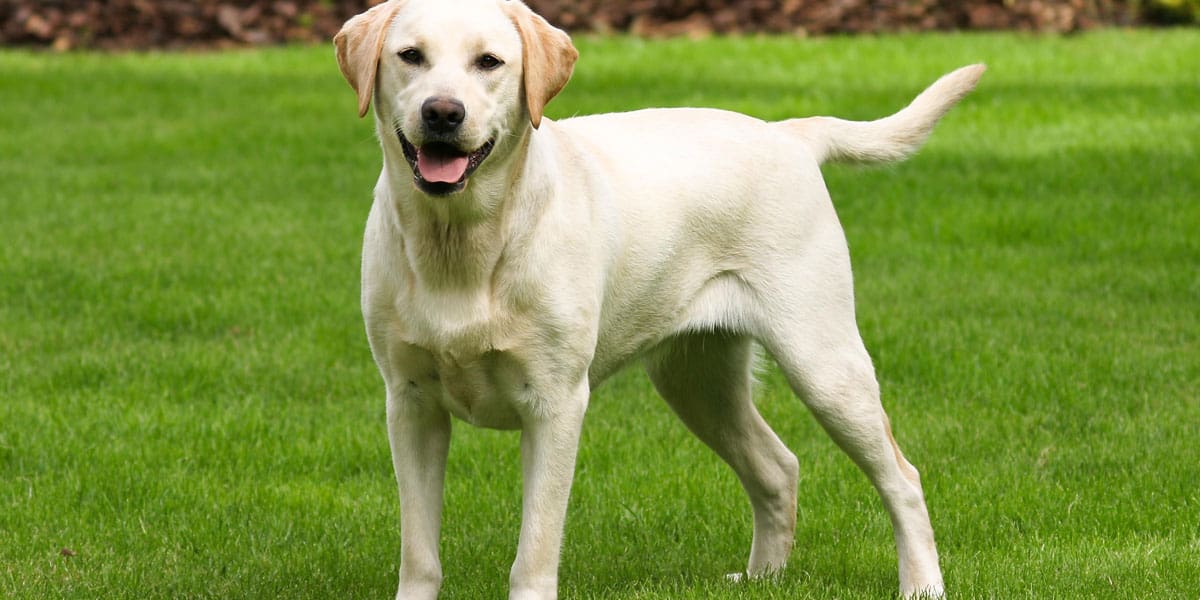Labrador Retriever Dog Breed Guide

Published on August 6th, 2019
The Labrador Retriever is generally considered to be the most popular dog breed worldwide.
In this dog breed guide, we’ll explore why labs are such brilliant family pets and what makes them so popular.
Disclosure: This post contains affiliate links, which means that I will earn a commission if you click through and make a purchase (at no additional cost to you).
A guide to the Labrador retriever dog breed
Labradors, also known as Labrador Retrievers or “labs” for short, are a medium-large dog breed that’s often touted as the perfect family dog.
They have short fur and stocky body builds. They were originally bred to be used in fishing, and as gundogs. Many are still used in this capacity today as working dogs.
Labradors are an intelligent breed who thrive on being mentally and physically stimulated.
They are also incredibly loving and loyal, and in general they are good with children and cats.
Key Statistics
- Life expectancy: 12 – 13 years
- Size: Medium-large breed
- Height: Males 22.5-24.5 inches, Females 21.5-23.5 inches
- Weight: Males 65-80lb, Females 55-70lb
- Colours: Black, Chocolate, Yellow (which ranges from almost-white to fox-red)
- Source

Fun facts about Labradors
- Labradors are excellent swimmers as they were first bred to be used for retrieving items in the water. The are double-coated with a water-resistant layers which helps them to swim.
- Labradors can reach speeds of up to 12 miles an hour in just three seconds!
- Labs are the most common dog breed to be trained to be guide dogs.
- All three colours can be present in a single litter of puppies. It’s common for a mother dog to birth different coloured puppies.
- A Labrador called Tubby holds the Guiness World Record for “most bottles recycled by a dog”
- The dog ‘Marley’ from the book and film ‘Marley and Me’ was a yellow Labrador
- Despite their name, Labradors are actually from Newfoundland, not Labrador
- The AKA officially recognised Labradors as a breed in 1917, mostly thanks to the third Earl of Malmesbury
- The oldest registered Labrador lived to be 27 years old. His name was Adjutant and he lived in the United Kingdom.
- According to Guiness World Records, the first dog to detect diabetic episodes was a Labrador called Armstrong.
- Labradors are the third most popular dog breed in the UK

Frequently asked questions about Labradors
If you are thinking about buying a Labrador puppy or adopting a rescue Labrador then you probably have lots of questions.
Here are the answers to some common questions about getting a Labrador to help you out:
What health problems do Labradors have?
Labradors can be susceptible to several different health problems, particularly as they get older.
This doesn’t mean that every Labrador will get these conditions, but you should be aware that they are a possibility.
Being aware of dog breed health problems before you decide which dog to get is helpful because you often find that pet insurers do not cover conditions that are breed-specific, or common to that breed.
Some health problems that Labradors are susceptible to are:
- Joint problems such as hip dysplasia
- Bloat (also called a twisted stomach)
- Obesity (particularly as they get older and their activity levels naturally drop)
- Ear infections
- Heart disease
Find out more here.
Are Labradors a good family dog?
Generally speaking, Labradors make an excellent family dog.
They are loyal, trustworthy, loving and intelligent and are usually easy to train.
However, it must be noted that every dog has a different temperament, so you cannot guarantee that every lab will make a good family dog.
Are Labradors from Labrador?
Despite their name, Labrador Retrievers actually originate from Newfoundland.
The story of where Labradors come from is complicated and quite interesting. Find out where Labradors are from here.
Are there different types of Labrador?
There are two recognised types of Labrador: the English Labrador and the American Labrador.
The English breeds tend to be heavier, thicker and more blocky in appearance.
In terms of colour, there are three different colours: black, chocolate and yellow.
Chocolate labs can also be referred to as brown or liver in colour.
Yellow Labradors can very drastically in colour. Some yellow Labradors look almost white, some are quite yellow in appearance and others are a fox red colour.
Do labs bark a lot?
Labs don’t tend to bark a lot. They are often quite dogs who rarely bark, if at all.
However, much of this is due to training at a young age.
If you fail to train your dog out of barking and they get into the habit then it can be hard to break, particularly when the dog becomes over-excited.
Are Labradors a good dog?
Their easy-going natures make Labradors a good dog in general.
They can make a good first dog for families that have never had a dog before, but equally they are suitable for experienced dog owners.
As with any dog breed, each individual has their own temperament and characteristics. This, combined with the level of training, exercise and companionship that the dog receives can all affect whether or not the lab is a ‘good dog’.
What colour lab is the best?
The most popular colour lab is probably the yellow colour. This is the colour most commonly associated with guide dogs.
Black Labradors tend to be favoured for gun dogs.
Chocolate labs are usually for show and therefore not typically used in gun competitions or as working dogs.
Are Labradors smart?
Labradors are considered to be an intelligent breed. Their intelligence combined with their loyalty and eagerness to learn is why they are one of the most used breeds for guide dogs and assistance dogs.

Are Labradors hard to train?
In general, Labradors are fairly easy to train because they are eager to please and highly likely to be extremely treat-orientated.
Labs are incredibly energetic, particularly at a young age, so suitable exercise is needed to make them be more susceptible to being trained. If they are too bouncy and full of energy, then they may find it difficult to concentrate on what you are trying to teach them.
What age do Labradors calm down?
Labradors are highly energetic as puppies and young dogs.
In general, they will start to calm down from about 1 year old, although it can take a couple of years for them to really settle in and calm down.
The ‘terrible twos’ isn’t just for toddlers – it can easily apply to dogs as well!
How long can you walk a Labrador puppy?
Puppies need less exercise than adolescent and adult dogs. Too much walking at a young age can damage their joints and potentially cause arthritis.
The Kennel Club suggests 5 minutes of exercise per month of their current age, until they are fully grown. So, for example, a 3-month old Labrador should have 15 minutes of exercise.
Try not to exercise your puppy on a full stomach as this can increase their chances of developing bloat which is a dangerous condition also known as twisted stomach.
How often should you walk a Labrador?
A Labrador of standard build and health needs about 1 hour of exercise per day.
Merely walking with your dog is not always enough, especially for young adult dogs who will have boundless energy.
Instead, try to exercise them in different ways that will both physically and mentally stimulate (and tire!) them.
Exercise can be made of up of different activities, for example: running, swimming, playing fetch and jogging with their owners.
How many hours a day do Labradors sleep?
Dogs tend to sleep longer than humans as they don’t enter REM sleep as easily as we do, so they need more hours of sleep to fully recharge themselves.
A Labrador puppy may sleep for up to 20 hours a day. They have lots of growing to do, which uses their energy!
An adult Labrador will probably sleep for about 12 hours out of every 24, although some days that may be more or less depending on how much exercise they have had that day – and just their general mood!
How long can a Labrador be left alone?
As with any dog, Labradors should not be left alone on a regular basis for more than about six hours.
If left longer they can become destructive due to boredom or start to develop separation anxiety.
There is also the risk that they will relieve their bladders or bowels inside the house as it’s a long time for a dog to wait for you to come home if they need to “go”.
If you need to leave your Labrador for long periods of time, perhaps when you are at work, then you should either arrange a doggie daycare for your Labrador or book a dog walker to come and lunch time and take them on a walk for at least one hour.
When you are leaving your Labrador alone for the first time, try to start simple by just leaving them for five minutes or so (just walk to the end of the road and back) and gradually increase the duration of the time they are left.
This can be to ease any initial separation anxiety, and get your dog used to being left alone.
What age is a Labrador fully grown?
Labradors can become fully grown as soon as 6 months old, however it can take up to 12 months for them to reach their full height.
Even after that, it can take until they are around two years old for them to ‘fill out’ and gain the stockiness that’s typical of the breed.
More information about Labrador Retrievers
If you’d like to learn more about this family-friendly dog breed then check out these resources:
- Whitwam, Linda (Author)
- English (Publication Language)
- 284 Pages - 04/27/2017 (Publication Date) - CreateSpace Independent Publishing Platform (Publisher)
- Mattinson, Pippa (Author)
- English (Publication Language)
- 192 Pages - 10/01/2015 (Publication Date) - Ebury Press (Publisher)
- Fogle, Ben (Author)
- English (Publication Language)
- 272 Pages - 03/10/2016 (Publication Date) - William Collins (Publisher)








